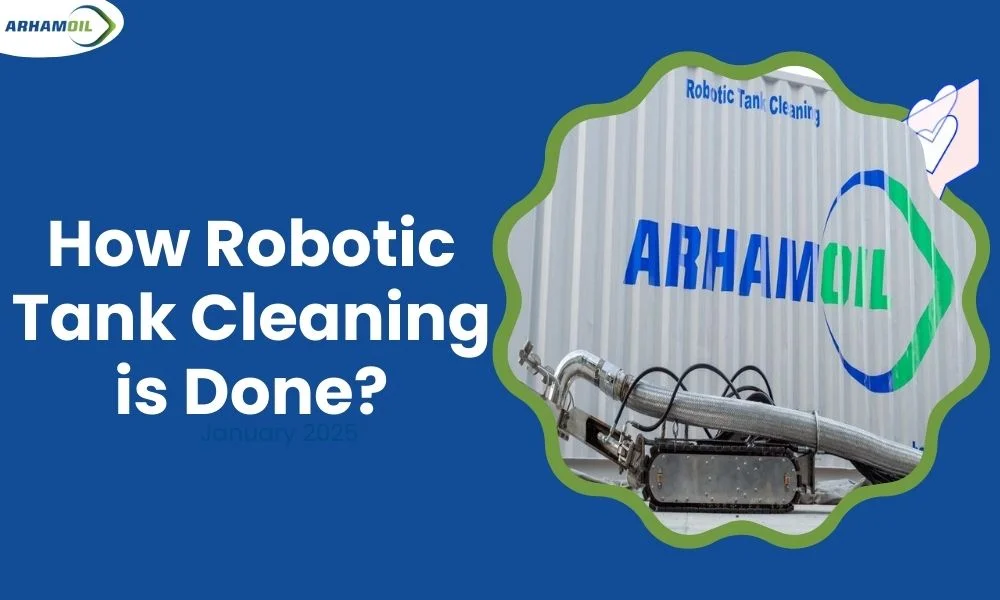How Robotic Crude Oil Tank Cleaning Works?
March 7, 2025Lagoon Cleaning Costs: Manual vs. Robotic Methods Compared
March 21, 2025Introduction: The Danger Lurking Inside Oil Tanks
Picture a massive crude oil storage tank. Inside, layers of sticky sludge cling to the walls, toxic gases linger, and corroded metal threatens structural integrity. Cleaning these tanks meant sending workers into harm’s way for decades—until robotics transformed the process. At Arham Oil, we’ve spent years refining robotic tank cleaning to prioritize safety, precision, and sustainability. Here’s a detailed look at how we do it—and why our approach is unmatched.
Step 1: Preparation—Safety First, Always
Before any robot enters a tank, meticulous planning ensures safety and efficiency.
- Tank Isolation: Following strict industry protocols, the tank is emptied and isolated from operations.
- Gas-Freeing: Inert gases like nitrogen purge explosive fumes, creating a safe environment.
- Access Setup: Small entry points are opened for robots—no need for human-sized hatches or scaffolding.
Step 2: Inspection & Mapping—Seeing the Unseen
Robots don’t just clean—they understand the tank’s condition.
- Deploy Inspection Robots: ATEX-certified bots enter the tank, equipped with advanced sensors.
- LiDAR 3D Mapping: Lasers scan every inch, creating a digital twin of the tank’s interior. This reveals sludge buildup, corrosion hotspots, and structural weaknesses.
- Sludge Analysis: Sensors detect sludge composition (e.g., paraffin, sand, or water-oil mixtures) to customize cleaning.
Step 3: Precision Cleaning—Where Tech Meets Expertise
This is where robots shine—and our operators’ expertise guides them.
- High-Pressure Jets: Robots spray water at pressures strong enough to dislodge sludge but gentle enough to protect tank walls.
- Adaptive Cleaning: Operators adjust nozzle angles and pressure remotely based on live camera feeds. For example, thicker sludge gets higher pressure; fragile areas get delicate sprays.
- Vacuum Extraction: Sludge is sucked into sealed containers as it’s removed, preventing leaks or spills.
Step 4: Waste Recycling—Turning Hazard into Value
Sludge isn’t waste—it’s a resource.
- Separation Process: Centrifuges split sludge into oil, water, and solids.
- Reuse & Recycle:
- Recovered oil is refined for reuse.
- Solids become asphalt or construction materials.
- Water is treated and safely discharged.
- Environmental Compliance: Detailed recycling reports help you meet ESG goals and avoid fines.
Step 5: Final Checks & Certification—Your Guarantee of Quality
Cleaning isn’t complete until every standard is met.
- Ultrasonic Testing: Robots scan tank walls for hidden corrosion, ensuring long-term safety.
- Detailed Report: Includes sludge removal metrics, corrosion maps, and maintenance recommendations.
- OSHA Compliance Certificate: Issued promptly, so your tank can return to operations quickly.
Case Study: Transforming a Struggling Refinery
Client: A refinery plagued by frequent shutdowns, safety incidents, and mounting fines.
Challenges:
- Workers refused hazardous manual cleaning jobs.
- Sludge buildup caused production delays.
- Regulatory fines for improper waste disposal.
Arham’s Solution:
- Deployed robotic cleaners to eliminate human entry.
- Customized sludge recycling for asphalt production.
- Trained the client’s team to operate dashboards and review compliance reports.
Results:
- Safer operations: No injuries or fines post-implementation.
- Faster turnaround: Tanks returned to service quicker than ever.
- Positive feedback: Workers praised the shift to tech-focused roles.
Why Arham Oil is the Industry Leader!
- Safety Legacy:
- Zero human entry since our founding.
- Explosion-proof robots are certified for hazardous environments.
- Innovation:
- Proprietary tech like SmartSludge™ and AdaptiveJet™—unavailable elsewhere.
- Continuous upgrades based on client feedback.
- Partnership:
- We train your team, share real-time data, and tailor solutions to your needs.
Ready to Revolutionize Tank Cleaning?
Robotic tank cleaning isn’t a luxury—it’s a necessity for modern, responsible operations. At Arham Oil, we’ve perfected a process that protects workers, boosts efficiency, and turns sludge into value.
Take the First Step Today:
📞 Contact us for a free consultation | 📋 Download our “Beginner’s Guide to Robotic Cleaning” | 🤝 Join our satisfied clients
FAQs: Your Questions, Answered
Q1: How does robotic cleaning improve safety?
A: Robots handle all hazardous tasks inside the tank. Workers avoid toxic fumes, explosions, and confined-space risks. Our ATEX-certified bots are built for volatile environments.
Q2: Can robots clean all types of sludge?
A: Yes! From sticky paraffin to sandy residues, our AdaptiveJet™ tech adjusts to any sludge type.
Q3: What happens to the sludge after removal?
A: Most is recycled—oil is reused, solids become asphalt, and water is treated. We ensure eco-friendly disposal.
Q4: How long does the process take?
A: Far faster than manual methods. While timelines vary by tank size, robotic cleaning often cuts downtime by half.
Q5: Why choose Arham Oil over others?
A: We’re pioneers with unmatched expertise:
- No competitors match our safety record.
- Proprietary tech ensures precision.
- We prioritize partnership, not just transactions.


